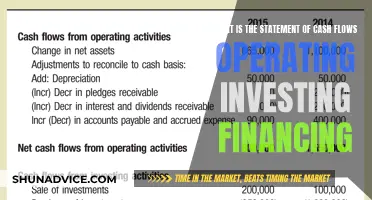
Using a line of credit to invest can be a risky move, but it may pay off if you do your research and understand the potential downsides. A line of credit can provide quick access to cash, allowing you to seize investment opportunities or cover unexpected expenses. It can also be useful if you need to bridge financing, such as when you're buying a new home while selling your existing one. The interest rates on lines of credit are typically lower than credit cards or personal loans, and the money can be used for various purposes without triggering capital gains tax. However, it's important to remember that the value of your investments can fluctuate, and if it declines significantly, you may be forced to deposit additional funds or sell a portion of your portfolio to repay the loan. The interest rates on lines of credit are also variable, which means they can increase at any time, especially in a rising interest rate environment. Before using a line of credit for investing, carefully consider the risks, ensure you have a repayment plan in place, and don't borrow more than you can afford to repay.
| Characteristics | Values |
|---|---|
| Interest rate | Variable and/or fixed |
| Collateral | Unsecured or secured with real property |
| Repayment schedule | Flexible, no minimum payments or early payment penalties |
| Risk | High interest rates, late payment fees, potential to spend more than can be repaid |
| Benefits | Access to instant, ongoing funds; great for unclear costs; similar flexibility to credit cards but with lower interest rates |
What You'll Learn

Pros of using a portfolio line of credit
A portfolio line of credit can be a useful tool for investors, offering several advantages over traditional loans or credit cards. Here are some pros of using a portfolio line of credit:
Lower Interest Rates
Compared to traditional loans or credit cards, a portfolio line of credit often comes with lower interest rates. This is because the investments in your brokerage account act as collateral, signalling a lower chance of default to the brokerage. The reduced risk for the broker often makes it easier to qualify for this type of credit.
Flexible Repayment
There is usually no set repayment schedule with a portfolio line of credit. You can repay on your own terms, with no minimum payments or early repayment penalties. This flexibility allows you to manage your cash flow more effectively.
Quick Access to Cash
A portfolio line of credit can provide fast access to cash, often within a day or even a few hours. This can be beneficial for short-term financing needs or unexpected expenses.
No Credit Check
Since your investments serve as collateral, there is typically no credit check required for a portfolio line of credit. This can be advantageous for those with poor credit histories or those looking for a more streamlined borrowing process.
Tax Benefits
Borrowing against your portfolio does not trigger capital gains tax. Additionally, interest costs may be tax-deductible if you itemize your expenses.
Morris Invest: The Cash-Only Strategy Explained
You may want to see also

Cons of using a portfolio line of credit
Using a portfolio line of credit can be risky. Here are some cons to consider:
Risk of Owing More
The value of your investments fluctuates with the market, so a volatile environment could have negative repercussions. If the value of your portfolio declines, you may be forced to deposit additional funds or sell a portion of your portfolio to repay some of the loan.
Margin Call
If your portfolio value declines below a certain threshold, triggering what's known as a "margin call", you may be required to deposit additional funds (aka add more collateral) or sell a portion of your portfolio to repay some of the loan.
Variable Interest Rates
The interest rate on a portfolio line of credit is not locked, meaning that the rates can go up or down at any time. In a rising rate environment, this type of loan could get more expensive as rates increase.
Overleveraging
If you take out too much money, you run the risk of becoming "overleveraged" by borrowing too large a percentage of your portfolio value.
Limited Shopping Around
Because your assets are with one institution, a loan eliminates your ability to shop around for the best rate unless you are willing to leave your current broker.
Investing Cash Flow: Exploring Other Items
You may want to see also

How to use a line of credit responsibly
Using a line of credit responsibly can be a delicate task. Here are some tips on how to do it:
Understand the risks and benefits
Before using a line of credit, it is important to weigh the risks and benefits. Lines of credit can provide versatility and flexibility, but there are also potential downsides, such as high-interest rates, late payment fees, and the risk of spending more than you can afford to repay. It is also important to remember that the interest rates on lines of credit tend to be variable, which can make it difficult to predict the total cost of borrowing.
Have a clear repayment plan
It is crucial to have a concrete repayment plan in place before taking out a line of credit. Make sure you understand the minimum monthly payments and the repayment schedule. Failing to make payments on time can result in late fees and damage your credit score.
Use it for the right purposes
Lines of credit are best suited for unexpected expenses or projects with unclear costs. They are not intended to fund one-time purchases such as houses or cars. Consider using alternative financing options, such as personal loans or credit cards, for these types of purchases.
Shop around for the best rates
Interest rates and fees can vary significantly between lenders, so it is important to compare multiple offers before choosing a line of credit. Look for competitive rates and consider the potential impact of variable interest rates on your repayments.
Avoid over-leveraging
When using a line of credit, avoid borrowing more than you can afford to repay. Only borrow what you need and try to repay the funds as soon as possible to minimise interest charges. Keep in mind that the value of your collateral (if you have a secured line of credit) can fluctuate, and you may be required to deposit additional funds if the value declines.
Use it to improve your credit score
Using a line of credit responsibly can help build your credit score. Making regular, on-time payments demonstrates your creditworthiness and can improve your borrowing options in the future.
Investing.com: A Comprehensive Guide for Forex Traders
You may want to see also

Risks of a securities-backed line of credit
Securities-backed lines of credit (SBLOCs) are promoted by lenders as an easy and cost-effective way to access extra cash. However, they carry several risks that borrowers should be aware of.
One of the biggest risks is that the volatile nature of the market will affect the collateral value of your account. If the value of your securities declines, you will receive a "maintenance call" notifying you that you must post additional collateral or repay the loan within a short period. If you can't meet the requirements, the lender can sell your securities without your consent to satisfy the maintenance call. This could result in unintended tax consequences and potential losses if the market is volatile.
Additionally, the interest rates on SBLOCs are variable, meaning they can increase at any time. In a rising interest rate environment, your initially low-interest rate may start to climb, making the loan more expensive.
Another risk to consider is the potential for overleveraging. If you borrow a large percentage of your portfolio value, you may find yourself in a situation where you owe more than your portfolio is worth.
Furthermore, the terms of an SBLOC may change at the lender's discretion. The minimum required equity for a line of credit may be raised, or the lender may decide that certain securities are no longer eligible as collateral, reducing your credit limit.
Finally, using your investments as collateral may not be the best option. The value of your securities is constantly changing, and you may not have enough collateral to back your line of credit, triggering a maintenance call.
While SBLOCs can provide quick access to cash, borrowers should carefully consider these risks and have a concrete repayment plan in place to mitigate potential negative consequences.
Cash Reserves: Smart Investment Strategy or Missed Opportunities?
You may want to see also

Alternatives to a portfolio line of credit
If a portfolio line of credit doesn't seem like the right option for you, there are several other loan options available that might better suit your needs. Here are some alternatives to a portfolio line of credit:
- Home equity line of credit (HELOC): The interest expenses on a HELOC could potentially be deducted from taxes, making it an attractive option for financing home improvements. Interest rates are typically lower than those charged by credit cards and personal loans. However, your house is used as collateral, and the loan is considered a second mortgage if your home is not paid off. If you cannot pay your first and second mortgage, your home could be at risk of foreclosure.
- Traditional loans: You could use more traditional loans such as personal loans, car loans, or credit cards as an alternative. In some cases, you may also be able to access a loan from your 401(k) or 403(b) employer-sponsored retirement account.
- Credit card with a balance transfer option: In the right circumstances, it could make sense to use a credit card with a low-cost introductory offer or some other money-saving perk.
- Personal line of credit: A personal line of credit is an unsecured loan that can be used for various purposes. It is typically based on your creditworthiness and income, and you repay it in fixed monthly instalments over a specified period.
- Business line of credit: If you're a small business owner, a business or working capital line of credit could be a more suitable option. These loans fund business-related expenses such as starting a new venture, expanding operations, or purchasing equipment. They provide access to a predetermined amount of money that can be borrowed as needed.
Perforated Investment Flask: Easy Steps for Usage
You may want to see also
Frequently asked questions
A line of credit is a flexible loan from a bank or financial institution. It is similar to a credit card with a set credit limit, but it usually has a lower interest rate. You can borrow money as you need it and pay it back immediately or over time.
Using a line of credit to invest can give you quick access to cash, and the interest rates are typically lower than those of credit cards or personal loans. There is also no set repayment schedule, so you can repay the loan on your own terms.
The value of your investments can fluctuate with the market, so you may end up owing more than you initially borrowed. There is also a risk of the broker issuing a margin call, which means you will have to deposit additional funds or sell a portion of your portfolio to repay the loan.
Some alternative options include using a home equity line of credit (HELOC), taking out a personal loan, or using a credit card with a balance transfer option.







